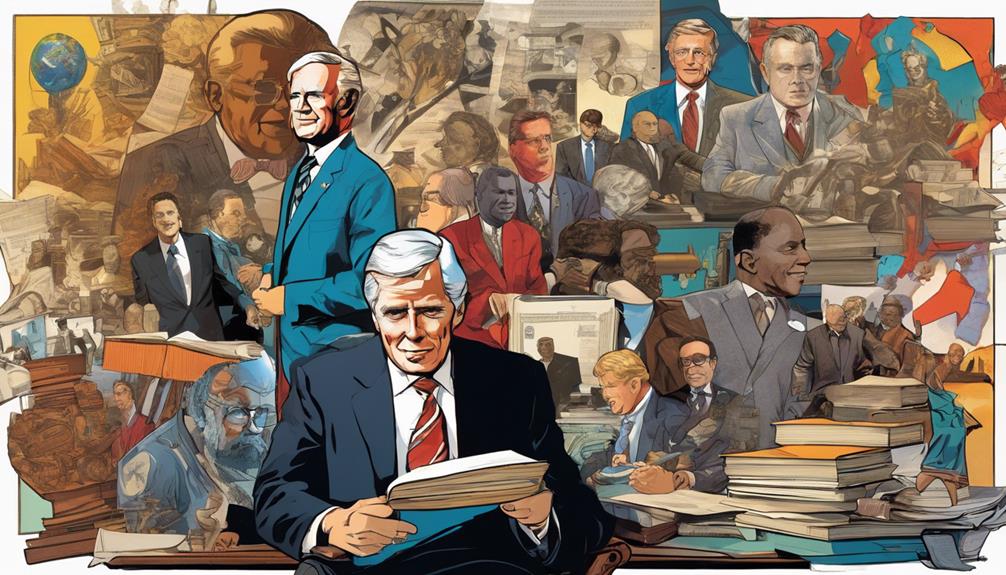Timeless wisdom from influential presidents offers valuable insights for maneuvering challenges. Embrace resilience, as leaders like Lincoln showed us during tough times. Remember, small achievements can build momentum and foster confidence, just as Eisenhower practiced. Prioritize core values and integrity, ensuring your leadership builds trust and respect. Focus on mutual belief; when you believe in yourself, others will too, inspiring a dynamic team. Also, cultivate empathy and respect to strengthen communication and relationships. Finally, the legacies of past presidents remind you that their words can guide you. Keep exploring their insights, and you'll uncover profound lessons for modern leadership.
Key Takeaways
- Effective leadership inspires collective action and shapes public opinion, as seen in the impactful words of influential presidents.
- Resilience and perseverance are crucial in overcoming challenges, highlighted by historical examples like Lincoln during the Civil War.
- Core values and integrity form the foundation of trustworthy leadership, fostering loyalty and respect among followers.
- Visionary leadership encourages innovation and creative thinking, paving the way for groundbreaking ideas that transform society.
Leadership and Inspiration
Effective leadership inspires you to unite and take collective action for a common purpose. When you witness a strong leader, you feel motivated to contribute to a shared vision. Their ability to shape national policies and public opinion encourages you to engage actively.
Leadership styles directly impact organizational culture, influencing how teams perform. Charismatic leaders often spark significant social change, making their actions resonate with you and others in your community. You understand that collective success hinges on team motivation, and empowered teams thrive under effective leaders.
In times of crisis, you see how decisive leadership can guide communities toward resolution. Ultimately, great leaders instill hope and drive, igniting a passion within you and your peers to achieve remarkable goals together.
Resilience and Perseverance

In the face of challenges, resilience and perseverance become essential traits that empower you to navigate obstacles and achieve your goals. When you encounter setbacks, remember the power of persistence. Each obstacle can teach you valuable lessons, shaping your path forward.
| Key Concept | Example | Quote |
|---|---|---|
| Resilience | Lincoln during the Civil War | "The harder the conflict, the more glorious the triumph." – Thomas Paine |
| Perseverance | Passage of the Affordable Care Act | "Change will not come if we wait." – Barack Obama |
| Long-term Success | Entrepreneurs overcoming failures | "Success is not final; failure is not fatal." – Winston Churchill |
Core Values and Integrity

While resilience and perseverance help you overcome challenges, core values and integrity serve as the foundation for trustworthy leadership and decision-making.
Your core values shape how you approach situations and influence your actions. When you remain steadfast in your principles, you build trust with those around you.
Thomas Jefferson emphasized the importance of standing firm on one's beliefs, reminding us that integrity fosters loyalty and respect.
By consistently aligning your decisions with your values, you create a strong organizational culture that encourages others to follow suit.
Honesty and transparency should guide your interactions, enhancing your credibility.
Ultimately, prioritizing core values and integrity not only elevates your leadership but also inspires those you lead to uphold the same standards.
Importance of Small Achievements

Small achievements pave the way for greater success by building momentum and motivation in your journey. When you focus on smaller, attainable goals, you create a sense of accomplishment that fuels your drive. Each small victory reinforces your belief in your abilities and propels you forward.
Think of Dwight D. Eisenhower, who championed pragmatic daily goals; his approach teaches us that progress is made step by step. Celebrating these minor milestones fosters resilience and keeps you engaged, even during challenging times.
Belief in Self and Others

Believing in yourself and others is essential for effective leadership and fostering a collaborative environment. When you have confidence in your abilities, it inspires those around you to do the same.
Think of Theodore Roosevelt, whose self-assurance propelled his leadership style and motivated countless individuals. Your belief can ignite passion and perseverance in your team, encouraging them to tackle challenges head-on.
Additionally, as Barack Obama demonstrated, persistence in the face of obstacles reinforces that determination matters. By cultivating self-confidence, you create a ripple effect, empowering others to trust their capabilities.
Ultimately, this mutual belief lays the foundation for a resilient and dynamic team ready to achieve great things together.
Respect and Empathy in Leadership

Respect and empathy are essential qualities that enhance your effectiveness as a leader, fostering stronger relationships and collaboration within your team. When you prioritize these traits, you create an environment where everyone feels valued and heard.
Here are three key benefits of embodying respect and empathy in your leadership style:
- Stronger Communication: Open dialogue flourishes when team members feel respected, leading to better understanding and fewer conflicts.
- Increased Trust: Showing empathy builds trust, making your team more willing to share ideas and take risks.
- Enhanced Motivation: When you respect and empathize with your team, they're more engaged, leading to higher productivity and morale.
Embrace these qualities to cultivate a thriving team dynamic and effective leadership.
Visionary Leadership and Innovation

Visionary leadership fosters innovation by encouraging creative thinking and challenging the status quo. When you embrace unique perspectives, you pave the way for groundbreaking ideas and advancements. Just like John F. Kennedy inspired a generation, your leadership can drive economic growth and social change.
Here's a table to illustrate key attributes of visionary leaders:
| Attribute | Impact | Example |
|---|---|---|
| Creative Thinking | Sparks innovative solutions | Kennedy's moon landing vision |
| Non-Conformity | Breaks barriers to progress | Roosevelt's New Deal |
| Embracing Diversity | Fosters collaboration | Obama's inclusive policies |
Legacy of Presidential Words

Presidential words often leave a lasting legacy, shaping national identity and reflecting the values and challenges of their time. These quotes resonate through generations, inspiring leaders and citizens alike. They remind you of the ideals and struggles that define your nation.
Here are three key aspects of their legacy:
- Cultural Reflection: Presidential quotes often mirror societal values and the pressing issues of their era.
- Inspiration for Future Generations: These words motivate and guide emerging leaders, encouraging them to aim for progress.
- Unity and Resilience: Powerful quotes can unite people during challenging times, fostering a spirit of perseverance and hope.
Conclusion
As you reflect on the timeless wisdom shared by influential presidents, remember their words are like a compass guiding you through the storms of life.
Embrace their lessons on leadership, resilience, and empathy, which can light your path in today's fast-paced world, much like a lighthouse illuminating a rocky shore.
By internalizing these messages, you not only honor their legacy but also empower yourself and those around you to create meaningful change and inspire future generations.









